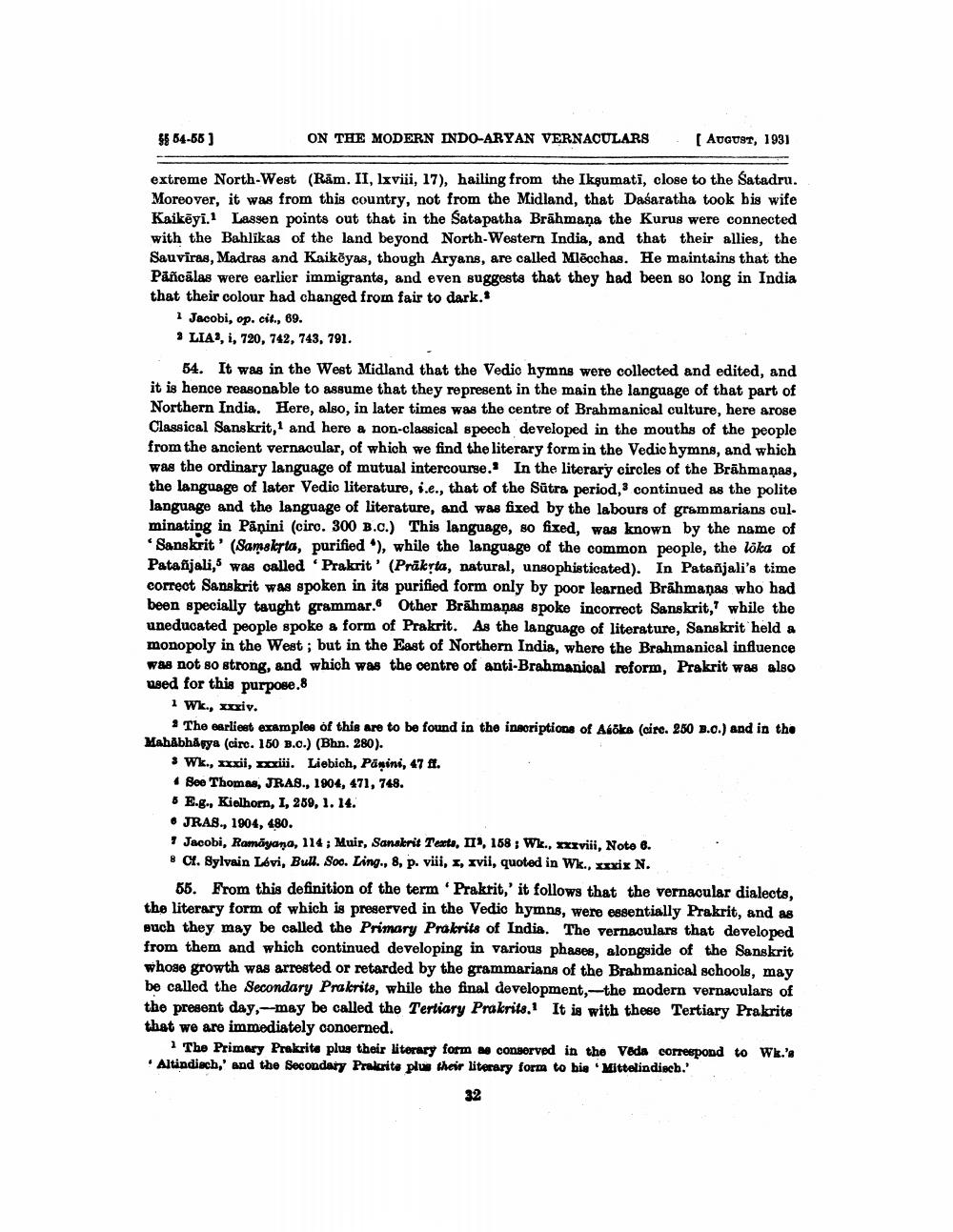________________
$854-58 )
ON THE MODERN INDO-ARYAN VERNACULARS
(August, 1931
extreme North-West (Rām. II, lxviii, 17), hailing from the Ikgumati, close to the Satadru. Moreover, it was from this country, not from the Midland, that Dasaratha took his wife Kaikēyi. Lassen points out that in the Satapatha Brāhmana the Kurus were connected with the Bahlikas of the land beyond North-Western India, and that their allies, the Sauviras, Madras and Kaiköyas, though Aryans, are called Mlēochas. He maintains that the Pāñcālas were earlier immigrants, and even suggests that they had been so long in India that their colour had changed from fair to dark..
1 Jacobi, op. cit., 69. LIA, i, 720, 742, 743, 791.
54. It was in the West Midland that the Vedic hymns were collected and edited, and it is hence reasonable to assume that they represent in the main the language of that part of Northern India. Here, also, in later times was the centre of Brahmanical culture, here arose Classical Sanskrit, 1 and here a non-classical speech developed in the mouths of the people from the ancient vernacular, of which we find the literary form in the Vedic hymns, and which was the ordinary language of mutual intercourse. In the literary circles of the Brāhmanas, the language of later Vedic literature, i.e., that of the Sütra period, continued as the polite language and the language of literature, and was fixed by the labours of grammarians oul. minating in Pånini (ciro. 300 B.C.) This language, so fixed, was known by the name of
Sanskrit ' (Samskrta, purified), while the language of the common people, the löka of Patañjali,' was oalled 'Prakrit' (Prakyta, natural, unsophisticated). In Patañjali's time correot Sanskrit was spoken in its purified form only by poor learned Brāhmanas who had been specially taught grammar. Other Brāhmaṇas spoke incorrect Sanskrit," while the uneducated people spoke a form of Prakrit. As the language of literature, Sanskrit held a monopoly in the West ; but in the East of Northern India, where the Brahmanical influence was not so strong, and which was the oentre of anti-Brahmanioal reform, Prakrit was also used for this purpose.8
1 Wk., xxxiv.
2 The earliest examples of this are to be found in the inscriptions of Aboka (cire. 250 D.O.) and in the Mahâbhagya (circ. 150 B.C.) (Bhn. 280).
3 Wk., xxxii, xii. Liebich, Panini, 47 ff. + See Thomas, JRAS., 1904, 471, 748. 6 E.g., Kielhorn, 1, 289, 1. 14. . JRAS., 1904, 480.
Jacobi, Ramayana, 114 ; Muir, Sanskrit Texte, II, 168 ; W., XXIviii, Noto 6. 8 Cl. Sylvain Lévi, Bull. Soo. Ling., 8, p. viii, , xvii, quoted in Wk., Xxxx N.
65. From this definition of the term 'Prakrit,' it follows that the vernacular dialects, the literary form of which is preserved in the Vedic hymns, were essentially Prakrit, and as euch they may be called the Primary Prakrits of India. The vernaculars that developed from them and which continued developing in various phases, alongside of the Sanskrit whose growth was arrested or retarded by the grammarians of the Brahmanical schools, may be called the Secondary Prakrits, while the final development, the modern vernaculars of the present day,--may be called the Tertiary Prakrits. It is with these Tertiary Prakrits that we are immediately conoerned.
1 The Primary Prakrita plus their literary form a conserved in the Veda correspond to Wk.' Altindiach,' and the Secondary Prakarite plus their literary form to big Mittelindiscb.'
32




